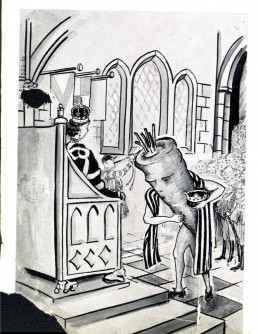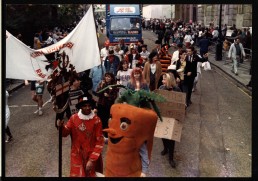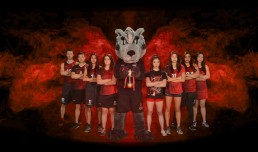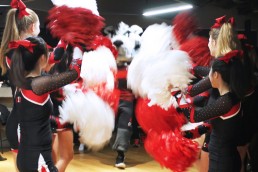Features | By Hamdi Khalif
The carrot and the wolf: The stories of City’s mascots
The sacred carrot
The story of King Carrot begins in June 1912 during an arduous journey to Palmers Green, where staff and students battled it out in an annual cricket match. The students were initially supposed to take a donkey-drawn carriage to the fields but decided on a motor bus in the end. They suspended a carrot from the front of the bus to mockingly symbolise their initial plan of arriving in a donkey-drawn carriage.
The carrot, made of wood and painted orange, led the teams to the grounds. “We told the staff we would play them for it, not realising that we … were about to lose both the match and the carrot” remembers E M Emtage in his article, featured in The N’ION. The students lost the cricket match and had the agony of watching a certain Mr Chalmers sling the carrot over his shoulder and install it in the Staff Common Room for the duration of the year.
It was then that the students decided to name the carrot as their official mascot and shortly after constructed a large cloth example. It survived until 1947 when it was succeeded by King Carrot II, which was two foot long, 15 inches wide and made entirely from aluminium.

King Carrot II presided over the old Union in the College Building. It was frequently stolen by rival unions, mainly University College and Queen Mary. King Carrot II once had the honour of appearing before the Diploma Committee of Crosse & Blackwell, the food production company specialising in condiments such as chutney. Its Diploma Committee assessed King Carrot II on 12th March 1958 and concluded the following:
Appearance: Most impressive
Flavour: Not sampled
Texture: Very rough
Despite his “most impressive” appearance, King Carrot II’s reign came to an end in 1962 when he was succeeded by a younger and larger carrot made of concrete and steel. Sadly, the promising new mascot was short-lived and in the year of his creation, he was removed and dumped in the River Thames. Popular belief has it that King’s College was behind the coup.
Since then, there have been many renditions of King Carrot and his legacy lives on today in the Carrot Awards, formerly the Nobel Order of the Carrot Awards, which acknowledged the services of students to the Students’ Union (SU) between 1925 and 1930. There is also Carrot Magazine and Carrot Radio and the SU Office is inevitably tinged with orange.


The sporting wolf
City Wolf was born in 2017 and despite rumours at the time, was never intended to replace the Carrot as the official SU mascot. Instead the gender-neutral was designed to help create a distinct identity for sports and sports students. It was hoped that the ‘pack mentality’ would foster the spirit of community and competition.
The Wolf is seven feet tall and wears a Team City sports kit. According to Yusuf Ahmed, then Vice President of Activities at the Students’ Union, who led the campaign to create a new mascot “The Wolf mascot was derived from the need for competitive sports at City to have their own identity”.

The Wolf, who also tweets, accompanies and supports students at sports games with the Central City All Stars cheerleading team. Unlike King Carrot whose existence is drenched in history, the story of the new sporting Wolf is just beginning.
I better get training now for next year's race! #cityuniwolf #clawsout https://t.co/rkt9cmf0tX
— cityuniwolf (@cityuniwolf) February 19, 2017
The sacred carrot
The story of King Carrot begins in June 1912 during an arduous horse-drawn omnibus journey to Palmers Green, where staff and students battled it out in an annual cricket match. When the omnibus carrying the teams was a little slow, a carrot was suspended above the horses’ noses to entice them to move faster. The carrot, made of wood and painted orange, led the teams to the grounds. “We told the staff we would play them for it, not realising that we … were about to lose both the match and the carrot” remembers E M Emtage in his article, featured in The N’ION. The students lost the cricket match and had the agony of watching a certain Mr Chalmers sling the carrot over his shoulder and install it in the Staff Common Room for the duration of the year.
It was then that the students decided to name the carrot as their official mascot and shortly after constructed a large cloth example. It survived until 1947 when it was succeeded by King Carrot II, which was two foot long, 15 inches wide and made entirely from aluminium.

King Carrot II presided over the old Union in the College Building. It was frequently stolen by rival unions, mainly University College and Queen Mary. King Carrot II once had the honour of appearing before the Diploma Committee of Crosse & Blackwell, the food production company specialising in condiments such as chutney. Its Diploma Committee assessed King Carrot II on 12th March 1958 and concluded the following:
Appearance: Most impressive
Flavour: Not sampled
Texture: Very rough
Despite his “most impressive” appearance, King Carrot II’s reign came to an end in 1962 when he was succeeded by a younger and larger carrot made of concrete and steel. Sadly, the promising new mascot was short-lived and in the year of his creation, he was removed and dumped in the River Thames. Popular belief has it that King’s College was behind the coup.

Since then, there have been many renditions of King Carrot and his legacy lives on today in the Carrot Awards, formerly the Nobel Order of the Carrot Awards, which acknowledged the services of students to the Students’ Union (SU) between 1925 and 1930. There is also Carrot Magazine and Carrot Radio and the SU Office is inevitably tinged with orange.

The sporting wolf
City Wolf was born in 2017 and despite rumours at the time, was never intended to replace the Carrot as the official SU mascot. Instead the gender-neutral was designed to help create a distinct identity for sports and sports students. It was hoped that the ‘pack mentality’ would foster the spirit of community and competition.
The Wolf is seven feet tall and wears a Team City sports kit. According to Yusuf Ahmed, then Vice President of Activities at the Students’ Union, who led the campaign to create a new mascot “The Wolf mascot was derived from the need for competitive sports at City to have their own identity”.

The Wolf, who also tweets, accompanies and supports students at sports games with the Central City All Stars cheerleading team. Unlike King Carrot whose existence is drenched in history, the story of the new sporting Wolf is just beginning.
I better get training now for next year's race! #cityuniwolf #clawsout https://t.co/rkt9cmf0tX
— cityuniwolf (@cityuniwolf) February 19, 2017